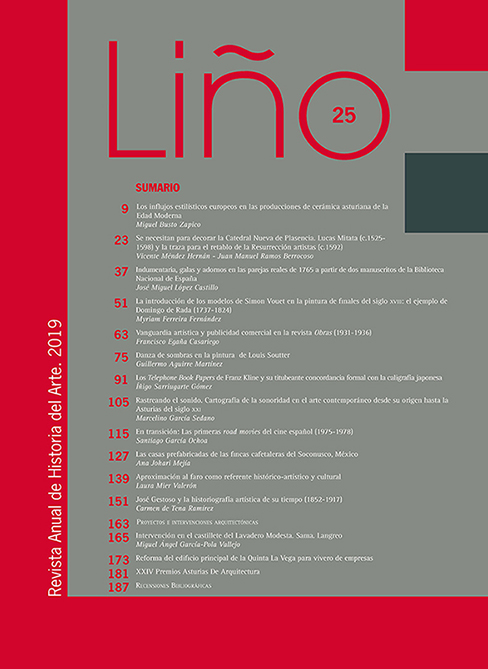Resumen
Franz Kline comenzó a ensayar sobre soportes que no eran habitualmente empleados en los procesos deductivos de los pintores expresionistas abstractos de la época, caso de las hojas de las guías telefónicas. El artista recabó un material de fácil uso y acceso, disponiendo de todo aquel que se necesitara, y de este modo poder eliminar los resultados no satisfactorios, ya que la disponibilidad de recursos era inagotable. También tuvo en consideración las reglamentaciones organizativas que aportaban las propias listas de teléfonos con la alineación de los nombres de los usuarios.
En base a una intensa revisión bibliográfica, se ha abordado un texto de carácter crítico-histórico con el objetivo de preponderar la importancia de los primeros procesos experimentales del pintor abstracto, al tratarse de indagaciones que se tornan fundamentales desde el punto de vista estratégico no sólo para la subsiguiente materialización de su obra más conocida, sino para dar salida al posterior debate gestado en torno a las supuestas influencias de la caligrafía japonesa en la conformación de sus trazos.
Citas
Addiss, Stephen. “Zen Painting and Calligraphy. History and Characteristics.” The Zen Art Book. The Art of Enlightenment. Stephen Addiss, y John Daido Loori. Boston: Shambhala. 2009. 11-26. Impreso.
Addiss, Stephen. The Art of Zen. Paintings and Calligraphy by Japanese Monks 1600-1925. New York: Harry N. Abrams, Inc. 1989. Impreso.
Alcopley, Lewin “The Club: The First Three Years.” Issue, A Journal for Artists, no.4 (fall 1985): 45-47. Impreso.
Buettner, Stewart. American Art Theory 1945-1970. Ann Arbor, Michigan: UMI Research Press. 1981. Impreso.
Clarke, David James. The Influence of Oriental Philosophy on Postwar American Painting and Sculpture. London: The Courtauld Institute. 1988. Impreso.
Crespo, Ana. La Realidad y la Mirada. El Zen en el Arte Contemporáneo. Madrid: Mandala Ediciones. 1997. Impreso.
Foster, Stephen C. Franz Kline and the Structure of Identity. London: Whitechapel Art Gallery; Milan: Electa, 1994. Impreso.
Fundació Antoni Tàpies. Franz Kline: arte y estructura de la identidad. Barcelona: Fundació Antoni Tàpies. 1994. Impreso.
García Gutiérrez, Fernando. Japón y Occidente. Influencias recíprocas en el arte. Sevilla: Ediciones Guadalquivir. 1990. Impreso.
Gaugh, Harry. F. Fanz Kline: The Color Abstractions. Washington, D.C.: The Phillips Collection. 1979. Impreso.
Gaugh, Harry F. The Vital Gesture: Franz Kline. Cincinnati: Cincinnati Art Museum; New York: Abbeville Press, 1985. Impreso.
Goldwater, Robert. "Introduction." Franz Kline, 1910-1962: Exhibition Catalogue. New York: Marlborough-Gerson Gallery. 1967. 5-7. Impreso.
Gotze, Heinz. Chinese and Japanese Calligrapy. Spanning Two Thousand Years. Munich: Prestel-Verlag. 1989. Impreso.
Graham-Dixon, Andrew. “ART / The master builder: Franz Kline didn't talk much about his work - one reason, perhaps, why others haven't much either. Andrew Graham-Dixon on a forgotten hero.” Independent, Tuesday 12 July 1994. Web: http://www.independent.co.uk/arts-entertainment/art/art-the-master-builder-franz-kline-didnt-talk-much-about-his-work-one-reason-perhaps-why-others-1413373.html. Última consulta: 13-06-2017.
Hess, Thomas B. “Interview.” New York Magazine, (April 7, 1972): s.p. Impreso.
Hess, Barbara. Expresionismo Abstracto. Madrid: Taschen. 2009. Impreso.
IdeelArt. “Franz Kline and His Action Painting Manner.” IdeelArt - The online gallerist for Contemporary Abstract Art. Web: http://www.ideelart.com/module/csblog/post/205-1-franz-kline.html. Última consulta: 03-02-2017.
Israel, Matthew. Franz Kline: “The Forgotten Abstract Expressionist?” The Huffington Post. 8 de diciembre de 2014. Web: http://www.huffingtonpost.com/matthew-israel/a-call-for-a-new-york-fra_b_5947262.html. Última consulta: 05-06-2017.
Jachec, Nancy. The Philosophy and Politics of Abstract Expressionism. Cambridge: Cambridge University Press. 2000. Impreso.
Kooning, Elaine de. Franz Kline Memorial Exhibition. Washington, D.C.: Washington Gallery of Modern Art, 1962. Impreso.
Kuh, Katherine. The Artist's Voice: Talks With Seventeen Modern Artists. New York: Harper & Row. 1962. Impreso.
McDarrah, Gloria. “The Club.” The Artist’s World in Pictures: The New York School. Fred W. McDarrah, y Gloria S. McDarrah. New York: Shapolsky Publishers. 1988. 69-76. Impreso.
Mediavilla, Claude. Caligrafía. Del signo caligráfico a la pintura abstracta. Valencia: Campgráfic Editors. 2005. Impreso.
Nicholas, Mary A. "We Were Born to Make Fairytales Come True: Reinterpreting Political Texts in Unofficial Soviet Art.” Canadian Slavonic Papers, 53, 2-4 (Jun-Dec 2011): 335-359. Impreso.
Rodman, Selden. Conversations with Artists. New York: Devin-Adair Co. 1957. Impreso.
Sandler, Irving. “The Club, How the Artists of the New York School Found Their First audience—Themselves.” Artforum 4 (September 1965): 27-31. Impreso.
Shan, Chong. “Chinese Calligraphy.” Chinese Painting & Calligraphy. 5th Century BC – 20th Century AD. Ed. Gong Jixian, y Li Shurui. Beijing: Zhaohua Publishing House. 1984. 121-130. Impreso.
Shin-ichi, Hisamatsu. Zen and the Fine Arts. Tokyo: Kodansha International Ltd. 1971. Impreso.
Tomii, Reiko, y Jeffrey Wechsler, y Midori Yoshimoto. “Exhibition as Proposition: Responding Critically to The Third Mind.” Art Journal. Vol. 68, 3 (Fall 2009): 31-51. Impreso.

